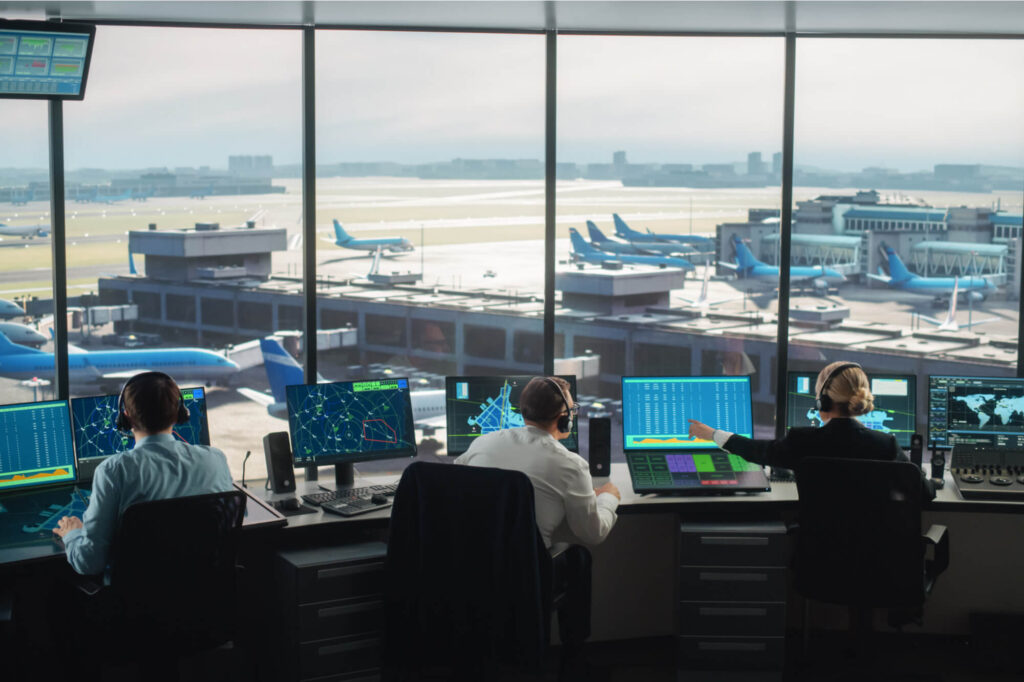All too often, people think about becoming a pilot when they think of aviation jobs. Eurocontrol is hoping to encourage people to think about a career as an air traffic controller instead.
Nicolas de Koninck, head of recruitment at Eurocontrol, said there were many reasons for young people to consider becoming an air traffic controller, including the fact that training is paid for, and a job is guaranteed at the end. That’s in contrast to most pilots, who have to pay tens of thousands for training without any guarantee of a job at the end, he pointed out.
“We’re here to promote the career,” de Koninck told AeroTime during the Pilot Expo 2022 in Berlin. “We fully pay for the training, so there is no financial investment from the students. In addition to that, we pay a salary during the training to the students, which increases as you progress throughout the training.” Shift work means working some unusual hours, but it’s planned in advance and for those interested in family life, you can be home every night, de Koninck highlighted.
It’s also an excellent choice for those looking for a challenge, de Koninck said.
“It’s very, very demanding – mentally, intellectually, physically,” he explained. “If you want to stretch yourself, we can provide you with a lot of challenges. So, air traffic control is therefore a good alternative to becoming a pilot.”

Air traffic controller Pim Rijnhout at Pilot Expo 2022. Credit: Kostas Kirilovas
“It’s easy for me to say, but I would not want to be a pilot,” Eurocontrol air traffic controller Pim Rijnhout told AeroTime at the training and recruitment trade fair. “Well, that’s not strictly true, I would love to be a pilot, but I love being a controller.”
Rijnhout initially wanted to become a pilot, but motion sickness put paid to his dreams. A visit to the Eurocontrol operations room after he ended his flight training set him on his new career. “I found the moment I went in, I loved it. I knew this was something I had to do.”
He would like to invite more people into the operations room to see for themselves what being a controller is actually like.
“People know what air traffic control is, but they don’t know what it actually means,” Rijnhout said. “I have taken people into the operations room and the funny thing is, the moment they come in, I observe them. And there’s no way in between – either you love it, or you hate it.”
Traffic returning
Now that European skies are busy again, Rijnhout can get back to his favorite part of the job – controlling planes. He works a sector that covers airspace over Belgium, the Netherlands, Luxembourg, and the northwestern part of Germany, above Flight Level 245 (approximately 24,500 feet or 7.5 kilometers) and is based in Maastricht.
“I do all kinds of side tasks, such as training and incident investigation, but sitting watching a radar screen and working lots of traffic is what brings me the most satisfaction,” he said.
Eurocontrol, which manages traffic flows across Europe, is predicting that traffic will recover to around 90% of pre-pandemic levels across the network in summer 2022, equivalent to over 30,000 flights per day.
While some areas, such as Poland, have seen staff shortages, de Koninck says Eurocontrol’s Maastricht center is ready for the upturn in traffic.
“Although COVID came, we decided not to stop training and not to stop selection. A lot of our competitors did,” he explained. “We did it at a lower pace and lower numbers, but we continued to bring in new students, we continued to train them, and to check them out when they’re ready, because we knew at some moment it could pick up again, and we wanted to be ready when it happened.”
Eurocontrol also started offering remote training during the pandemic, developing new exercises that could be done by people working from home and in different locations. Traffic levels were too low to perform checks for controllers to get their licenses, so simulators were used to create situations with medium and high traffic flows.
After two years of low volumes, Rijnhout said controllers were also given extra simulator sessions to practice getting used to higher traffic flows again.
“Even if some may still not feel 100% comfortable with working in high traffic flows, it’s also a relief for many to have the traffic back. This is why we became air traffic controllers – to do something that not everyone can do.”
How to apply?
Training takes between three and four years. To start training, you first have to meet certain criteria – you must have finished secondary education with mathematics as one of the subjects. You also have to be younger than 27 to start training at Eurocontrol, although other organizations, such as NATS in the UK, do not have this age requirement.
Eurocontrol is also keen to encourage applications from women. Currently the gender split is about 80:20 towards men, but de Koninck says recent training intakes have been more like 60:40.
Then you need to undergo a series of tests, assessments and interviews designed to test your suitability for the role, including spatial awareness, reasoning, decision making and group practical exercises.
“I do need to tell you that out of every 100 people who start the testing, on average five or six make it in,” de Koninck admits. “It’s quite tough. But I want to encourage people to try, because if you don’t try, you’ll never know!”
AeroTime talks to air traffic controller Pim Rijnhout at Pilot Expo 2022. Credit: Kostas Kirilovas

